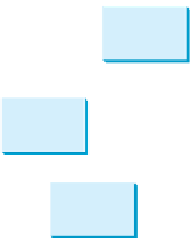Java Reference
In-Depth Information
parent
parent
current
may be a left or
right child of
parent
Subtree may be a left or
right subtree of
parent
current
current
points the node
to be deleted
No left child
Subtree
Subtree
(a)
(b)
F
IGURE
25.10
Case 1: The current node has no left child.
root
20
root
20
10
40
40
16
30
80
16
30
80
27
50
27
50
(a)
(b)
F
IGURE
25.11
Case 1: Deleting node
10
from (a) results in (b).
Note
If the current node is a leaf, it falls into Case 1. For example, to delete element
16
in
Figure 25.11a, connect its right child (in this case, it is
null
) to the parent of node
16
.
delete a leaf
Case 2:
The
current
node has a left child. Let
rightMost
point to the node that contains the
largest element in the left subtree of the
current
node and
parentOfRightMost
point to the
parent node of the
rightMost
node, as shown in Figure 25.12a. Note that the
rightMost
node
cannot have a right child but may have a left child. Replace the element value in the
current
node with the one in the
rightMost
node, connect the
parentOfRightMost
node with the
left child of the
rightMost
node, and delete the
rightMost
node, as shown in Figure 25.12b.
For example, consider deleting node
20
in Figure 25.13a. The
rightMost
node has the
element value
16
. Replace the element value
20
with
16
in the
current
node and make node
10
the parent for node
14
, as shown in Figure 25.13b.
Note
If the left child of
current
does not have a right child,
current.left
points to the
large element in the left subtree of
current
. In this case,
rightMost
is
current.
left
and
parentOfRightMost
is
current
. You have to take care of this special
case to reconnect the right child of
rightMost
with
parentOfRightMost
.
special case















































































Search WWH ::

Custom Search